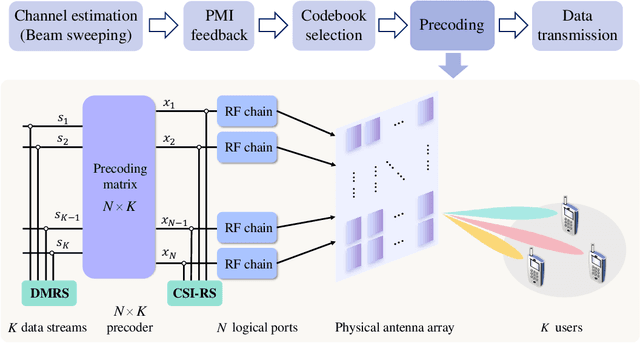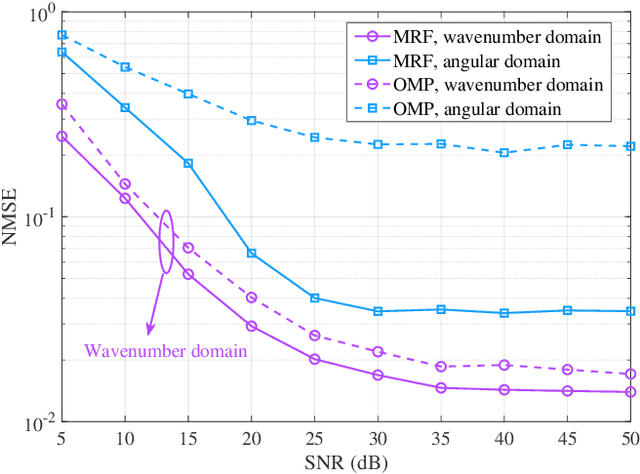Liyang Lu
New Paradigm for Unified Near-Field and Far-Field Wireless Communications
Jan 06, 2025



Abstract:Current Type I and Type II codebooks in fifth generation (5G) wireless communications are limited in supporting the coexistence of far-field and near-field user equipments, as they are exclusively designed for far-field scenarios. To fill this knowledge gap and encourage relevant proposals by the 3rd Generation Partnership Project (3GPP), this article provides a novel codebook to facilitate a unified paradigm for the coexistence of far-field and near-field contexts. It ensures efficient precoding for all user equipments (UEs), while removing the need for the base station to identify whether one specific UE stays in either near-field or far-field regions. Additionally, our proposed codebook ensures compliance with current 3GPP standards for working flow and reference signals. Simulation results demonstrate the superior performance and versatility of our proposed codebook, validating its effectiveness in unifying near-field and far-field precoding for sixth-generation (6G) multiple-input multiple-output (MIMO) systems.
Block-Dominant Compressed Sensing for Near-Field Communications: Fundamentals, Solutions and Future Directions
Mar 19, 2024



Abstract:Near-field (NF) communications draw much attention in the context of extremely large-scale antenna arrays (ELAA). Owing to a large number of antennas and high carrier frequency, the NF coverage distance is quite substantial, where the electromagnetic radiation propagates by spherical waves, in contrast to the conventional planar waves of the far-field. Motivated by these facts, the block-dominant compressed sensing (BD-CS) assisted NF communications are proposed. Specifically, we elucidate why block sparsity exists in the distance-limited NF region. Then, block-dominant side-information (BD-SI) is introduced in support of the actual NF communication implementation. We validate that BD-CS is capable of providing exceptional channel estimation accuracy and high spectral efficiency, where the associated challenges, opportunities and its actual implementation in NF communications need to be carefully addressed.
Near-Field Channel Estimation in Dual-Band XL-MIMO with Side Information-Assisted Compressed Sensing
Mar 19, 2024Abstract:Near-field communication comes to be an indispensable part of the future sixth generation (6G) communications at the arrival of the forth-coming deployment of extremely large-scale multiple-input-multiple-output (XL-MIMO) systems. Due to the substantial number of antennas, the electromagnetic radiation field is modeled by the spherical waves instead of the conventional planar waves, leading to severe weak sparsity to angular-domain near-field channel. Therefore, the channel estimation reminiscent of the conventional compression sensing (CS) approaches in the angular domain, judiciously utilized for low pilot overhead, may result in unprecedented challenges. To this end, this paper proposes a brand-new near-field channel estimation scheme by exploiting the naturally occurring useful side information. Specifically, we formulate the dual-band near-field communication model based on the fact that high-frequency systems are likely to be deployed with lower-frequency systems. Representative side information, i.e., the structural characteristic information derived by the sparsity ambiguity and the out-of-band spatial information stemming from the lower-frequency channel, is explored and tailored to materialize exceptional near-field channel estimation. Furthermore, in-depth theoretical analyses are developed to guarantee the minimum estimation error, based on which a suite of algorithms leveraging the elaborating side information are proposed. Numerical simulations demonstrate that the designed algorithms provide more assured results than the off-the-shelf approaches in the context of the dual-band near-field communications in both on- and off-grid scenarios, where the angle of departures/arrivals are discretely or continuously distributed, respectively.
Block-Sparse Tensor Recovery
Feb 04, 2024Abstract:This work explores the fundamental problem of the recoverability of a sparse tensor being reconstructed from its compressed embodiment. We present a generalized model of block-sparse tensor recovery as a theoretical foundation, where concepts measuring holistic mutual incoherence property (MIP) of the measurement matrix set are defined. A representative algorithm based on the orthogonal matching pursuit (OMP) framework, called tensor generalized block OMP (T-GBOMP), is applied to the theoretical framework elaborated for analyzing both noiseless and noisy recovery conditions. Specifically, we present the exact recovery condition (ERC) and sufficient conditions for establishing it with consideration of different degrees of restriction. Reliable reconstruction conditions, in terms of the residual convergence, the estimated error and the signal-to-noise ratio bound, are established to reveal the computable theoretical interpretability based on the newly defined MIP, which we introduce. The flexibility of tensor recovery is highlighted, i.e., the reliable recovery can be guaranteed by optimizing MIP of the measurement matrix set. Analytical comparisons demonstrate that the theoretical results developed are tighter and less restrictive than the existing ones (if any). Further discussions provide tensor extensions for several classic greedy algorithms, indicating that the sophisticated results derived are universal and applicable to all these tensorized variants.
Sparsity-Based Channel Estimation Exploiting Deep Unrolling for Downlink Massive MIMO
Sep 24, 2023



Abstract:Massive multiple-input multiple-output (MIMO) enjoys great advantage in 5G wireless communication systems owing to its spectrum and energy efficiency. However, hundreds of antennas require large volumes of pilot overhead to guarantee reliable channel estimation in FDD massive MIMO system. Compressive sensing (CS) has been applied for channel estimation by exploiting the inherent sparse structure of massive MIMO channel but suffer from high complexity. To overcome this challenge, this paper develops a hybrid channel estimation scheme by integrating the model-driven CS and data-driven deep unrolling technique. The proposed scheme consists of a coarse estimation part and a fine correction part to respectively exploit the inter- and intraframe sparsities of channels to greatly reduce the pilot overhead. Theoretical result is provided to indicate the convergence of the fine correction and coarse estimation net. Simulation results are provided to verify that our scheme can estimate MIMO channels with low pilot overhead while guaranteeing estimation accuracy with relatively low complexity.
Joint Block-Sparse Recovery Using Simultaneous BOMP/BOLS
Apr 10, 2023Abstract:We consider the greedy algorithms for the joint recovery of high-dimensional sparse signals based on the block multiple measurement vector (BMMV) model in compressed sensing (CS). To this end, we first put forth two versions of simultaneous block orthogonal least squares (S-BOLS) as the baseline for the OLS framework. Their cornerstone is to sequentially check and select the support block to minimize the residual power. Then, parallel performance analysis for the existing simultaneous block orthogonal matching pursuit (S-BOMP) and the two proposed S-BOLS algorithms is developed. It indicates that under the conditions based on the mutual incoherence property (MIP) and the decaying magnitude structure of the nonzero blocks of the signal, the algorithms select all the significant blocks before possibly choosing incorrect ones. In addition, we further consider the problem of sufficient data volume for reliable recovery, and provide its MIP-based bounds in closed-form. These results together highlight the key role of the block characteristic in addressing the weak-sparse issue, i.e., the scenario where the overall sparsity is too large. The derived theoretical results are also universally valid for conventional block-greedy algorithms and non-block algorithms by setting the number of measurement vectors and the block length to 1, respectively.
Compressive Spectrum Sensing Using Blind-Block Orthogonal Least Squares
Nov 14, 2022



Abstract:Compressive sensing (CS) has recently emerged as an extremely efficient technology of the wideband spectrum sensing. In compressive spectrum sensing (CSS), it is necessary to know the sparsity or the noise information in advance for reliable reconstruction. However, such information is usually absent in practical applications. In this paper, we propose a blind-block orthogonal least squares-based compressive spectrum sensing (B-BOLS-CSS) algorithm, which utilizes a novel blind stopping rule to cut the cords to these prior information. Specifically, we first present both the noiseless and noisy recovery guarantees for the BOLS algorithm based on the mutual incoherence property (MIP). Motivated by them, we then formulate the blind stopping rule, which exploits an $\ell_{2,\infty}$ sufficient statistic to blindly test the support atoms in the remaining measurement matrix. We further evaluate the theoretical performance analysis of the holistic B-BOLS-CSS algorithm by developing a lower bound of the signal-to-noise ratio (SNR) to ensure that the probability of exact recovery is no lower than a given threshold. Simulations not only demonstrate the improvement of our derived theoretical results, but also illustrate that B-BOLS-CSS works well in both low and high SNR environments.
Compressive Spectrum Sensing Using Sampling-Controlled Block Orthogonal Matching Pursuit
Nov 14, 2022Abstract:This paper proposes two novel schemes of wideband compressive spectrum sensing (CSS) via block orthogonal matching pursuit (BOMP) algorithm, for achieving high sensing accuracy in real time. These schemes aim to reliably recover the spectrum by adaptively adjusting the number of required measurements without inducing unnecessary sampling redundancy. To this end, the minimum number of required measurements for successful recovery is first derived in terms of its probabilistic lower bound. Then, a CSS scheme is proposed by tightening the derived lower bound, where the key is the design of a nonlinear exponential indicator through a general-purpose sampling-controlled algorithm (SCA). In particular, a sampling-controlled BOMP (SC-BOMP) is developed through a holistic integration of the existing BOMP and the proposed SCA. For fast implementation, a modified version of SC-BOMP is further developed by exploring the block orthogonality in the form of sub-coherence of measurement matrices, which allows more compressive sampling in terms of smaller lower bound of the number of measurements. Such a fast SC-BOMP scheme achieves a desired tradeoff between the complexity and the performance. Simulations demonstrate that the two SC-BOMP schemes outperform the other benchmark algorithms.
Downlink Massive MIMO Channel Estimation via Deep Unrolling : Sparsity Exploitations in Angular Domain
Oct 31, 2022Abstract:In frequency division duplex (FDD) massive MIMO systems, reliable downlink channel estimation is essential for the subsequent data transmission but is realized at the cost of massive pilot overhead due to hundreds of antennas at base station (BS). In order to reduce the pilot overhead without compromising the estimation, compressive sensing (CS) based methods have been widely applied for channel estimation by exploiting the inherent sparse structure of massive MIMO channel in angular domain. However, they still suffer from high complexity during optimization process and the requirement of prior knowledge on sparsity information. To overcome these challenges, this paper develops a novel hybrid channel estimation framework by integrating the model-driven CS and data-driven deep unrolling techniques. The proposed framework is composed of a coarse estimation part and a fine correction part, which is implemented in a two-stage manner to exploit both inter- and intra-frame sparsities of channels in angular domain. Then, two estimation schemes are designed depending on whether priori sparsity information is required, where the second scheme designs a new thresholding function to eliminate such requirement. Numerical results are provided to verify that our schemes can achieve high accuracy with low pilot overhead and low complexity.
Z-Code++: A Pre-trained Language Model Optimized for Abstractive Summarization
Aug 21, 2022



Abstract:This paper presents Z-Code++, a new pre-trained language model optimized for abstractive text summarization. The model extends the state of the art encoder-decoder model using three techniques. First, we use a two-phase pre-training process to improve model's performance on low-resource summarization tasks. The model is first pre-trained using text corpora for language understanding, and then is continually pre-trained on summarization corpora for grounded text generation. Second, we replace self-attention layers in the encoder with disentangled attention layers, where each word is represented using two vectors that encode its content and position, respectively. Third, we use fusion-in-encoder, a simple yet effective method of encoding long sequences in a hierarchical manner. Z-Code++ creates new state of the art on 9 out of 13 text summarization tasks across 5 languages. Our model is parameter-efficient in that it outperforms the 600x larger PaLM-540B on XSum, and the finetuned 200x larger GPT3-175B on SAMSum. In zero-shot and few-shot settings, our model substantially outperforms the competing models.
 Add to Chrome
Add to Chrome Add to Firefox
Add to Firefox Add to Edge
Add to Edge